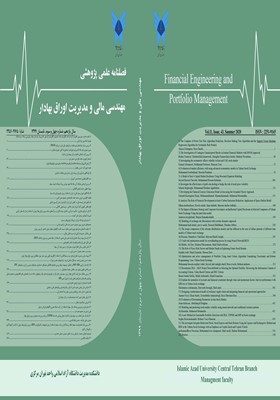Presentation DEA - MLP Neural NetworkModel in Selecting the Optimal Portfolio: Reviewing the Information Content of Accounting Criteria, Value-Based Criteria and BSC Criteria
Subject Areas : Financial engineering
Hasan Fattahi Nafchi
1
,
mehdi arabsalehi
2
*
,
Majid Esmaelian
3
![]()
1 - Department of Accounting. Faculty of Economics and Administrative Sciences, University of , Esfahan. esfahan, Iran.
2 - Department of Accounting. Faculty of Economics and Administrative Sciences, University of , Esfahan. esfahan, Iran.
3 - Department of Management. Faculty of Economics and Administrative Sciences, University of , Esfahan. esfahan, Iran.
Keywords: Data envelopment analysis, MLP Neural network, Optimal Stock Portfolios, Anomaly Algorithm,
Abstract :
Logical investment decisions require attention to different factors and different criteria at the same time. This goal can be achieved using various methods and algorithms. The purpose of this study is to develop an optimal stock portfolio model using a combination of data envelopment analysis methods, anomaly clustering algorithm and MLP neural networks.The statistical population of the research is the accepted companies in Tehran Stock Exchange during the period of 1386 to 1396. To create an optimal stock portfolio, all available criteria were grouped to reach the optimal stock portfolio.Then, the results were compared in different approaches based on the Sharp ratio. The results of the research indicate that using the combination of data envelopment analysis, anomaly clustering, MLP neural networks and accounting metrics in the provision of an optimal portfolio of stocks led to Increasing Sharp's ratio compared to other approaches (Risk and Efficiency, Value-Based, and Balanced Scorecard). In general, the simultaneous use of hybrid optimization techniques and comprehensive criteria derived from accounting reports can provide a more efficient basket of portfolios and more desirability for the investors.
Zhang, WG. & Nie, ZK. (2004). On Admissible Efficient Portfolio Selection Problem. Applied Mathematics and Computation, 159 (2), 357-371.
_||_1) Sinaii, Hassan Ali, and Ghastasbi Maharloi, Rasool (2011). Evaluating the efficiency and relative performance of companies with the data coverage analysis approach in order to form a stock portfolio. Journal of Accounting Knowledge, 3(11). 132-105.
10) Kaplan, R. S., & Norton, D. P. (1996). The Strategy-Focused Organization: How Balanced Scorecard Companies Survive in the New Business Environment, Boston, MA: Harvard Business School Press.
11) Kocadagli, Ozan; & Ridvan Keskin (2015). A Novel Portfolio Selection Model Based on Fuzzy Goal Programming with Different Importance and Priorities. Expert Systems with Applications, 42(20), 6898-6912.
12) Lehmann, D. R., Zahay, D., & Peltier, J. W. (2013). Survey analyze customer relationship management using balanced scorecard. Journal of Interactive Marketing, 27(1), 1-16.
13) Ratnasingam, P. (2009). Service quality management applying the balanced scorecard: An exploratory study. International Journal of Commerce and Management, 19(2), 127-136.
14) Song, Irene (2014). New Quantitative Approaches to Asset Selection and Portfolio Construction. Dissertation of Doctor of Philosophy, Columbia University.
15) Vapnik, V., 1998, Statistical Learning Theory. Wiley, New York.
2) Namazi, Mohammad, and Azimibidgholi, Mustafa (1391). Determining the criteria of balanced evaluation and their ranking using the process of hierarchical analysis in the companies accepted in the Tehran Stock Exchange. Financial Accounting Quarterly, 10(35), 1-12.
3) Namazi, Mohammadov and Ghafari, Mohammad Javad. (2014). Investigating the importance and role of managers' ability information and financial ratios as a criterion in choosing the optimal stock portfolio in companies listed on the Tehran Stock Exchange (using data coverage analysis). Financial Accounting Quarterly, 7(26), 1-30.
4) Ben Abdelaziz, F., Aouni, B. & Fayedh, R.E. (2007). Multi-Objective Stochastic Programming for Portfolio Selection. European Journal of Operational Research, 4(177). 1811-1823.
5) Cevikalp, H. (2010). New Clustering Algorithm for the Support Vector Machine Based Hierarchical Classification. Pattern Recognition Letters, 31(18), 1285-1291.
6) Chen, T. Y., & Chen, L. H. (2007). DEA performance evaluation based on BSC indicators incorporated: The case of semiconductor industry. International Journal of Productivity and Performance Management, 56(4), 335-357.
7) Cunha Callado, A. A., & Jack, L. (2015). Balanced scorecard metrics and specific supply chain roles. International Journal of Productivity and Performance Management, 64(2), 288-300.
8) Halkos, G. E., & D. S., Salamouris (2004). Efficiency Measurement of the Greek Commercial Banks with the Use of Financial Ratios: A Data Envelopment Analysis Approach, Management Accounting Research, 15(2), 201-224.
9) Horngren, C. T., Datar, S. D., & Rajan, M. V. (2012). Cost accounting: A managerial emphasis (14th ed). New Jersey, USA: Pearson Prentice Hall.
Zhang, WG. & Nie, ZK. (2004). On Admissible Efficient Portfolio Selection Problem. Applied Mathematics and Computation, 159 (2), 357-371.

